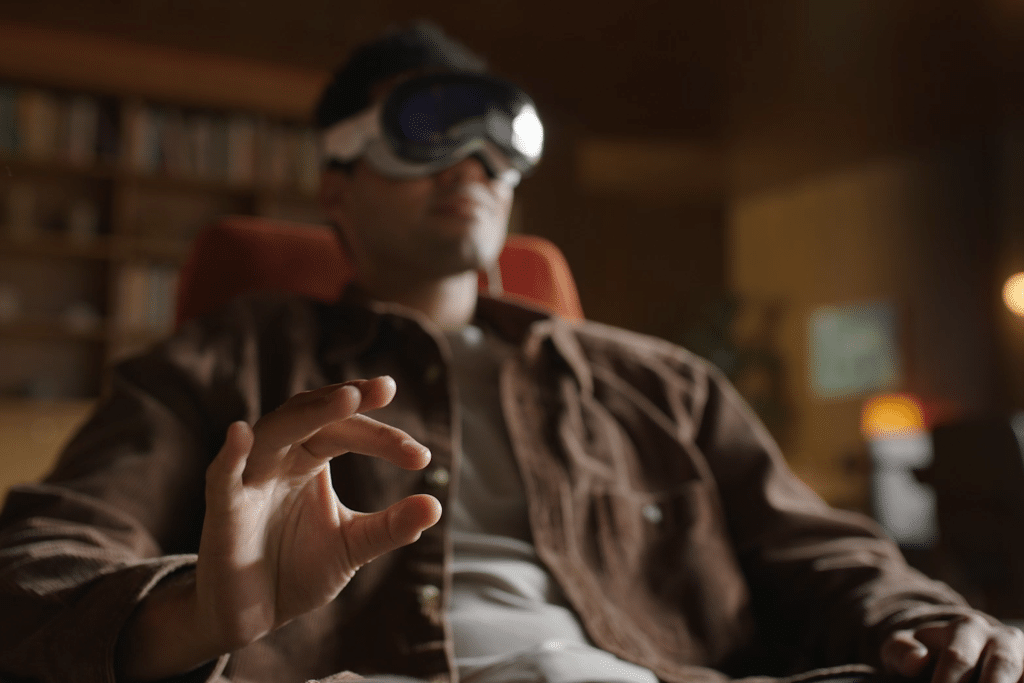VoiceOver, Apple’s screen reader, is a standout feature in visionOS, enabling blind or low-vision users to navigate the Vision Pro’s immersive interface through audio cues. Activated by triple-clicking the Digital Crown or via Siri, VoiceOver describes on-screen elements like app names, battery levels, and incoming calls. It uses distinct sounds to signal app transitions or view changes, helping users orient themselves in the 3D environment. Single-hand pinches, multi-hand gestures, and slide pinches allow interaction with virtual objects, while a practice mode lets users master these controls without affecting settings. Tutorials, accessible through settings, guide users in real time, making the learning curve manageable. This robust implementation, detailed in Apple’s support documentation, ensures blind users can fully engage with spatial computing.
Zoom: Magnifying the Mixed Reality World
For users with low vision, visionOS’s Zoom feature leverages the Vision Pro’s advanced camera system to magnify both digital and physical surroundings. Users can enable Zoom via the Accessibility settings or by triple-clicking the top button, choosing between Full Screen Zoom for the entire view or Window Zoom for a movable lens. The Digital Crown adjusts magnification levels, while head movements pan the view in Full Screen mode, offering intuitive control. The Zoom Controller, customizable through a connected Magic Keyboard, allows precise adjustments to zoom regions and levels. According to Apple, this feature integrates with the device’s main camera to enhance visibility of real-world objects, such as reading a menu or inspecting a whiteboard, making the Vision Pro a practical tool for everyday tasks.
Eye Tracking: Intuitive Control Through Gaze
visionOS takes eye tracking to new heights, enabling users with motor impairments to interact with the device using gaze-based navigation. Custom eye-tracking calibration ensures accuracy, allowing users to select apps or elements by looking at them and performing a pinch gesture. This feature, highlighted in developer documentation, supports Switch Control for Brain-Computer Interfaces, letting users with severe mobility limitations navigate using thought-based commands. Eye tracking also integrates with Voice Control, where users can dictate text or issue commands like “open Safari” hands-free. These tools, combined with head-tracking capabilities, make the Vision Pro accessible to users who rely on alternative input methods, offering a seamless and empowering experience.
Real-World Object Detection and Accessibility Reader
Beyond voice, zoom, and eye support, visionOS introduces advanced features like Live Recognition, which uses on-device machine learning to describe surroundings, identify objects, and read documents aloud for blind users. This capability, powered by the Vision Pro’s camera, enhances independence by providing real-time audio descriptions of the environment. The Accessibility Reader, a system-wide feature, transforms text—whether on-screen or in the physical world—into a customizable format with adjustable fonts, colors, and spacing. Designed for users with dyslexia or low vision, it also supports spoken content, ensuring text is accessible in any context, from apps to physical books.
Practical Impact for Users
These accessibility features make the Vision Pro more than a futuristic gadget; they transform it into a tool for inclusion. VoiceOver allows blind users to explore mixed reality independently, while Zoom empowers those with low vision to engage with both digital and physical spaces. Eye tracking and Voice Control open the device to users with motor challenges, offering intuitive ways to interact without physical strain. The addition of Live Recognition and Accessibility Reader further bridges the gap between virtual and real-world usability, making tasks like reading or navigating unfamiliar spaces more manageable. Together, these tools reflect Apple’s commitment to ensuring technology serves everyone, regardless of ability.
Developer Support and Future Potential
Apple has also equipped developers with tools to enhance accessibility in visionOS apps. APIs allow third-party apps like Be My Eyes to access the Vision Pro’s camera for live, person-to-person assistance, expanding real-world support for visually impaired users. SwiftUI and UIKit integration ensures apps can incorporate VoiceOver, Zoom, and eye-tracking features seamlessly. As developers leverage these tools, the ecosystem of accessible apps is expected to grow, further amplifying the Vision Pro’s impact. With these foundations in place, visionOS sets a new standard for inclusive design in mixed reality.
